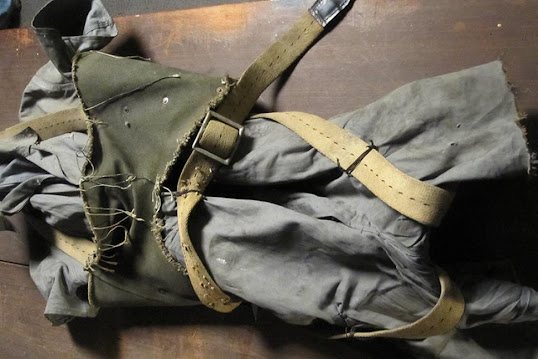.jpg)
In the Anthracite Mine Museum at Knoebels, there's a machine where you can search Anthracite Mine Accident Reports from 1913-1936.
I didn't take the time to try this out myself, but now I'm wishing I had looked a little closer. The Pennsylvania Historical Museum Commission has some records online, but I don't see records specifically for 1913-1936, so I am uncertain what this database is from.
https://www.phmc.pa.gov/Archives/Research-Online/Pages/Coal-Miner-Records.aspx
===================
The Sheppton Mine Rescue
====================
Harness Used In The Sheppton Mine Rescue
Sheppton PA is located about 40 minutes east of Knoebels.
On August 13th 1963, the roof of the Sheppton Anthracite Coal Mine collapsed, trapping 3 miners 300 feet below ground. It took several days to bore a small hole down to the mine, to ascertain that two of the three men were alive in a small chamber.
David Fellin, age 58, had been a miner for 4 decades. He dug a hole to reach sulfurous water that he and 30 year old Henry "Hank" Throne gagged down. Fellin had remembers seeing Mahatma Gandhi survive on the water during hunger strikes, and he and Thorne pressed on their Adams apples after drinking, as Fellin had seen Gandhi do in newsreels.
A wider bore hole was drilled down, allowing supplies to be passed down the miners. Then Billionaire Howard Hughes provided a bit that could drill a hole wide enough for a man to fit through.
News crews were on the scene constantly throughout the two week ordeal, the broadcasts were watched across the nation.
On August 27th 1963, Dellin and Throne donned helmets and strapped into parachute harnesses. Rescuers then pulled them through the bore hole to the surface.
This was one of the first ever rescues of trapped miners accomplished by raising them through holes bored through solid rock.
Louis Bova, the third miner, was never located.
The harness was featured on Season 3 Episode 8 of Mysteries At The Museum, on the Travel Channel.
Several books have been written about the rescue. The two most popular are
The Famous Sheppton Mine Rescue: The Untold Story: the Blood and Sweat of the Rescue Team Paperback by J. Ronnie Sando
And Sheppton: The Myth, Miracle & Music by Maxim W. Furek, which explores the Throne and Fellin's folie à deux - they both having related similar stories of having seen human-like figures (including the recently deceased Pope John XXIII), crosses, stairs, and other religious imagery.
=====================.jpg)
The museum first opened in 1988.
Most of the equipment in the museum are from the collection of the late Clarence “Mooch” Kashner of Coal Township. Kasner was once president of the Independent Miners, Breaker men, and Truckers union, and a retired PA State Mine Inspector. He asked Peter Knoebel to display the artifacts and memorabilia he’d acquired throughout his career. In 1988, the museum, a building built to resemble a coal breaker, was opened.
.jpg)
Sculptures by Knoebels Artist in Residence Matt Rusnak.
.jpg)
.jpg)





.jpg)
.jpg)
Actually the museum is the result of two mine inspectors, "Mooch" Kashner and Harold Shomper. I knew Shomper, he was one of my dad's patients and would go visit and listen to his stories. I recall he said by law they must to recover the miners, dead or alive. The rescuers Shomper said ultimately petitioned the PA State Supreme Court that there was a real risk of more loss of life to continue and they were allowed to stop. Hung out with Mooch once or twice. Going to a auction with him for mining artifacts for their museum was, shall we say, unique. Still have a bunch of anthracite year books, (one of which listed my great-grandfather's death.)
ReplyDelete